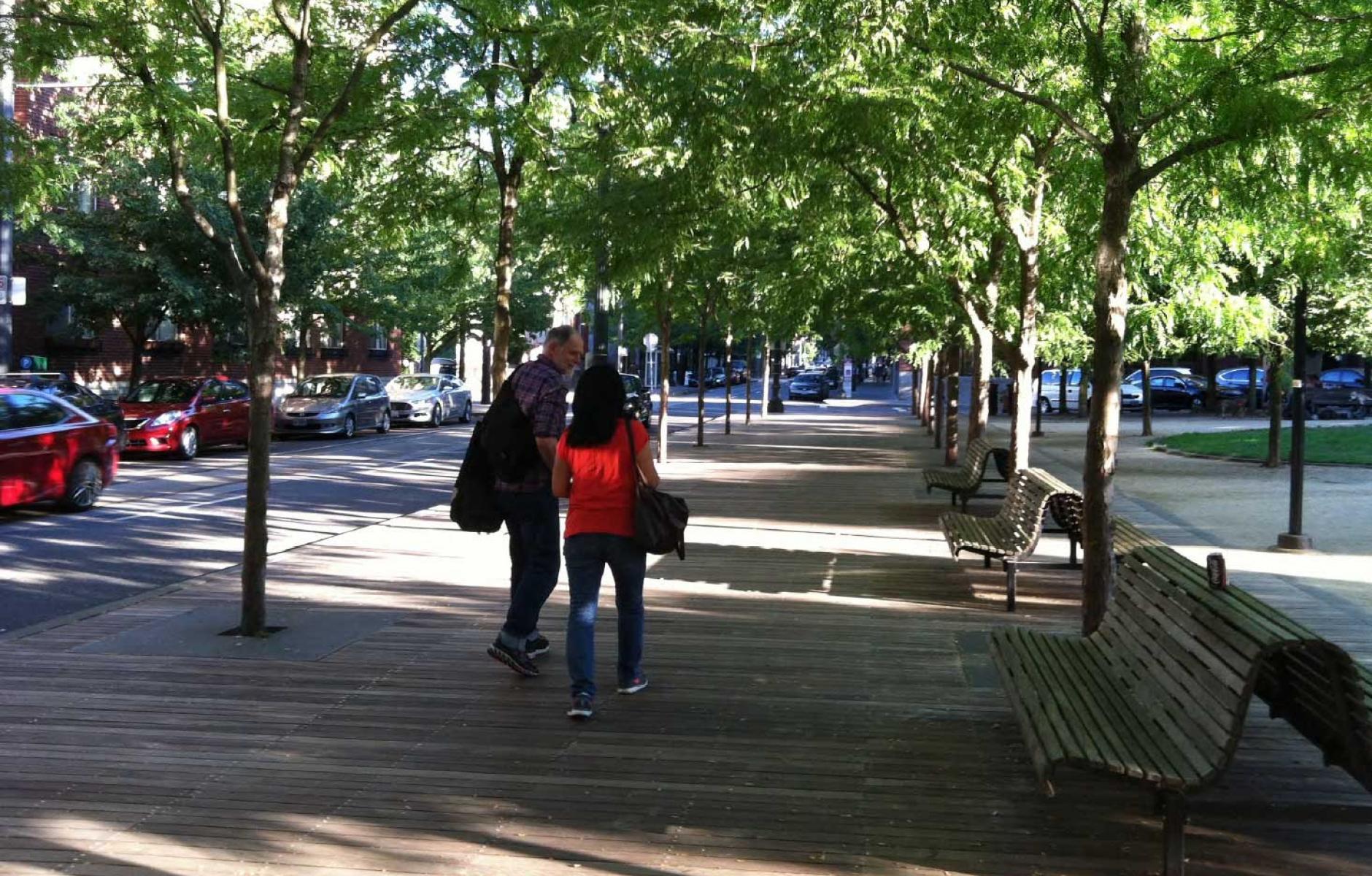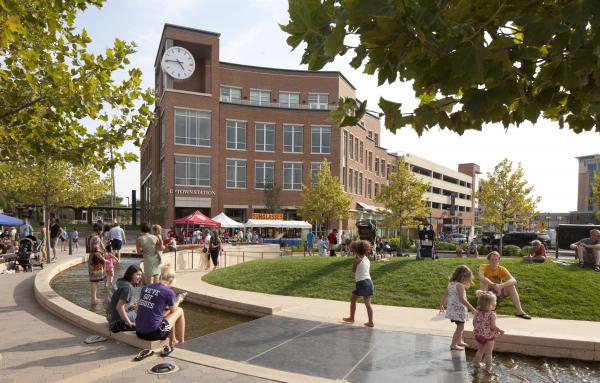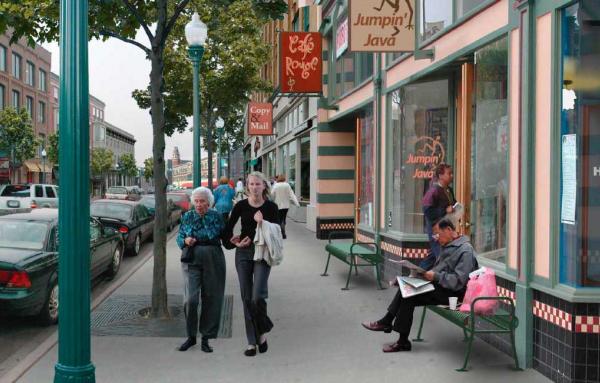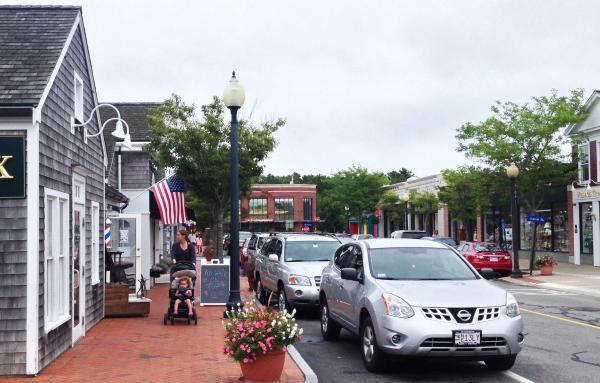
Great idea: Interconnected street networks
In celebration of the upcoming CNU 25.Seattle, Public Square is running the series 25 Great Ideas of the New Urbanism. These ideas have been shaped by new urbanists and continue to influence cities, towns, and suburbs. The series is meant to inspire and challenge those working toward complete communities in the next quarter century.
In order to get good streets, you have to think beyond any single street—an idea that is at the core of New Urbanism. Dendritic networks lead to fragmented and dispersed land uses at the local, municipal, and regional levels. The Charter says "Interconnected networks of streets should be designed to encourage walking, reduce the number and length of automobile trips, and conserve energy."
Public Square editor Robert Steuteville interviews Norman Garrick, associate professor of civil and environmental engineering with the University of Connecticut, and architect and urban designer Marcy McInelly of Urbsworks on street networks and why they are so important to cities and towns.

People talk about complete streets, the idea that streets should be for all users by often including features like bike lanes and crosswalks. But new urbanists talk about networks. What is so important about networks?
McInelly: Networks are necessary because complete streets are often misused to promote the idea that all functions must go on a single street. That's obviously not possible in a city, especially if we're going to accept that rights of way are constrained. This is a positive thing because we have to think about how to use the space that we have more constructively. You have to start thinking about all the modes that you're dealing with in a network, and also about the place that you're creating in the street and what kind of public space and public function that place performs. Networks have a placemaking focus that other organizations don’t really look, and I have to credit Norman with that idea because he was faithful to it from the very beginning.
Garrick: Our focus on street networks is at the very core of the CNU—the concept of street networks as opposed to hierarchical branched systems, which clearly do not build community. That’s how you build suburbia. So if you're starting to think about building places that function in more holistic ways, then street networks are the platform through which you're going to do that.
Could you talk a little bit about the history of street networks and how they changed in the second half of the 20th century?
Garrick: The change was influenced by the modernist and Garden City movements from the '20s. As cars came into prominence, they were thought too dangerous, and we needed to find a way to separate people from cars. So there was a good motivation behind the ideas that led, ultimately, to suburban cul-de-sacs. In particular, the Federal Housing Authority in the 1930s published a pamphlet that labeled certain types of street networks as either bad or good. Most of the bad ones were the traditional patterns that we see in American cities, while the good ones were a precursor to suburbia. Because of the depression and World War II, we didn't see a lot of this implemented until the 1960s following the Housing Act of 1949 and the Interstate systems. All these things together led to this change in how we built street networks. But the patterns did not stop there. We kept seeing an evolution where things became much more fragmented over time. We started to see much more free form, looser patterns into the '80s and '90s.

I've heard the term loops and lollipops for that later stage.
Garrick: Yes, that would certainly be a good description.
McInelly: I would add that these streets used to be the public realm of cities. They were for people to occupy—for commerce, for big events. They were not set up for cars or even for forms of transit. If you watch old movies with cities before cars became prominent, the way that their space works is very different from today. It's a primal civic space for the good of people. When cars became more prominent, we started to develop this dendritic system to separate people from cars. This was born out of a very compartmentalized mode of thinking about transportation. And it's also very engineering-driven—no offense to Norman. Engineered thinking tends to focus on how street networks function as movement spaces—but they're also places for sedentary activity. What we try to do in the blue book (CNU’s Sustainable Street Network Principles) is to explain the importance of the public realm.

When I first launched New Urban News and started to count New Urbanist projects, I would look for the street networks first. People talked a lot about mixed use, but that wasn't the first thing I looked for. If there was a network in the plan, it was likely a New Urbanist project. If there isn’t a network it really isn’t New Urbanism, is that correct?
Garrick: I think that's exactly the point. The street network is the foundation, it’s the structure. All of those things mixed-use projects are tied together through street networks. As we change from thinking about places separated according to land use with very homogenous patterns of development, we need to rethink how we think about street networks.
McInelly: There are a lot of projects by new urbanists that aren't networks and I don't want to spend much time talking about those. We have a legacy I'm uncomfortable with of developing greenfield areas that are not connected to any larger network. You might have a network within them, but it's a glorified cul-de-sac.
Garrick: You're right, Marcy. I think it's something that we need to talk about because that's how we're going to move forward. I'm not necessarily critical of these projects because I think that is the best you can do given the regulations in different places. But what looks like a network project is really a partial network.
Marcy, you alluded to the blue book you produced, the guide to sustainable street networks. Can you tell me about its genesis and why it took the form that it did, organized into principles?
McInelly: The blue book is one piece of the total effort. We'd been having transportation summits since 2002, but in 2005 we started to focus on what we were trying to achieve with this CNU street network concept. This helped to bring about the ITE context-sensitive design manual, which was a way to rethink streets completely. As Norman said, we realized that networks were critical and were neglected by almost everybody else that was working on the street. People were thinking about streets in the singular. You fix “a street” or think about “a street,” but we realized that you have to think about the entire network in order to rethink any one street.
In 2009 we published this book as a reaction to the technical character of the Designing Walkable Urban Thoroughfares manual that CNU and ITE collaborated on. We wrote [the blue book] as if CNU was working independently and was able to set its own terms of what a street network would consist of and look like. I still find it an amazingly written piece of work. Each statement is extremely complicated and complex but simply written. And it was illustrated in a way that was more about people than about modes.
So up until about 1950, Americans either lived in the country, sometimes on a farm, or in settlements like towns and cities. And these towns and cities were connected with street networks. Now most Americans live in vast metro areas built with suburban street systems. How do we reform those metro areas and those street systems, or can we?
Garrick: There should be a natural alliance between people doing suburban retrofit and folks that want to push the street network. It's really tough to retrofit most of suburbia, but we need to start. There are two places where I think the discussion of street networks are important. One is in terms of new development. When we're building new places and trying to join the development and usages, we need to think strongly with a network viewpoint. And then we look at rebuilding in cities themselves. We need to focus on how to restore some of the connectivity that most American cities lost with urban renewal and freeways. If you look at Detroit, for example, where there are freeways, we also have connectivity lost in places like Lafayette Park just to the east of the downtown.

McInelly: I'm working on a project right now in the Willamette Valley in Oregon that is an example of some of the challenges that network thinking can alleviate. There's an old road connecting the center of the city with its farmland outside. And over the years, it's been requisitioned for arterial status, meaning that it's now a major thoroughfare for fast-moving cars. But it historically had storefronts, complete neighborhoods, transit service and the urban complexity that we're trying to restore. There's a grid of streets of that comes up to it that we're trying to reconnect by creating more protected intersections for cars, bikes, and pedestrians to cross. But we're struggling against a misinterpretation of a Complete Streets policy. This city rewrote their Transportation System Plan (TSP) so that arterials now must include a bike lane. But this street does not have enough room in the right of way to have good sidewalks, bike lanes, traffic, and the on-street parking that is necessary to serve the marginal retail that everybody would like to see more of. We've instituted a road diet—which would take these four lanes and turn them into one lane in each direction and a center turn lane with planted medians. But the TSP, written with Complete Streets intent, said that we cannot institute a road diet without including bike lanes on both sides. So we're forced to put in bike lanes and sacrifice the sidewalk. We're trying to promote the idea to this city that they can’t fit everything on one street. There are parallel streets and crossings that are going to be more desirable for bikes.
Garrick: That’s a great example of why we need network thinking. Complete streets makes a really great bumper sticker, but talking about the intricacies is much more difficult. It's not as easy to get across the importance and the subtlety of networks as it is to say that we need complete streets.
The street network is the bones upon which the community's built—and it's analogous to the form-based code, which determines the mixed use and the form of the buildings. But it seems that this is more difficult because there is no regulatory analogy to a form-based code that's determining the street network.
McInelly: They usually have to write a transportation system plan, and they're now beginning to incorporate the complete street concepts into those plans. These plans are policy and they also determine how they're going to spend money over a 10 or 15 year period. TSPs are becoming more multimodal—but they still lack a network focus, although more and more cities like Charlotte and Pasadena are doing a really great job of that.
Garrick: I think it’s a much more difficult issue to tackle than codes. The ITE-CNU manual broke the stranglehold on people's thinking with regards to functional classification. It was one of the first to say that functional classification is problematic in cities. Engineers do not understand that implicit in functional classification is this hierarchical network— the anti-urban street network—and that patterns are built into the very structure of functional classification. We need to continue to push the idea that we cannot use functional classifications in urban areas if we are going to create the same type of street networks that function as they did 100 years ago.
McInelly: Sometimes federal funding also drives this automobile-centric thinking. It's not always possible in a policy document like a city's transportation system plan to even consider the other functions of the network. What about the pedestrian network? What about the bike network? Federal funding is often used by cities as a way to prioritize the network for automobile efficiency. This is where I think the lack of central funding and more local innovation is going to actually be a good thing.
Norman, you've done a lot of research on street networks. Can you talk about what you've found in terms of the influence on safety and health?
Garrick: We have compared different types in Californian cities, with different street networks. We have found that traditional networks that are very dense have a much higher share of walking and biking. In terms of health outcomes such as obesity, diabetics, and heart diseases, we're finding that in places with these dense connected networks, if you correct for factors like income and race, people tend to be much healthier than those in more suburban patterns.

And what have you found with regard to traffic safety?
Garrick: There's a huge impact on traffic safety. In particular, it's not so much that there are less accidents, it's that the accidents that are happening are much less severe in dense connected places.
McInelly: Is that due to the speed of vehicles?
Garrick: Yes, that's the working hypothesis. We have not measured it yet, but there is a lot to suggest that it is due to difference in speed.
Marcy, what have your observations been with regard to the impact of street networks on livability?
McInelly: For most people, it's a real eye-opener when you tell them that up to 40 percent of the space in cities is either streets or parks. That's public space that belongs to everybody and ought to benefit everybody. But in many cities, that space is mostly used by cars—not even by transit. The most important part of New Urbanism is that people have started to clamor, both nationally as policy and locally in their cities, for rethinking the way that public space is used. More and more people are joining neighborhood efforts to repaint the streets and reclaim the streets for people.
People often think that if you create more streets, they will all still look like wide arterials. But the street becomes more human-scale if you have a denser network.
McInelly: The more robust your network is, the more variety in types of streets you're going to have. And you're right that a lot of people when you mention the need for a network or the benefits of the network, they think, "Oh, more streets. That just means more cars, more cars, more cut-through traffic, more traffic, more problems." But you have to explain that now it means a dispersion of the traffic, because there are going to be more choices about where you walk, or bike, or drive. There's more variety. Some streets will be able to be narrower and intimate, and other streets might be wider and grand. That is one of the livability benefits of the network.
Garrick: That’s a key point because there are examples of dysfunctional networks that have been built, which don't have variety or the ability to create these kinds of different environments. One of the difficulties is to get across to people the idea that a connected street network can have the intimate, slow-traffic environment where your kids can actually play on the street. But it comes down to how the network is designed. While there are really good examples, there are also very bad examples where we have connected street networks that lack those features. People react to those bad examples and to the fact that the majority of streets they know are horrible traffic sewers. To them, a network is horrifying because they see a network of traffic sewers all over the place. But part of the reason we have traffic sewers is that we went away from network thinking in the first place.
Have you been working on any really interesting projects that involve street networks?
Garrick: The new town center that we created in Storrs, Connecticut, it's a very small network but the network aspects that were built into it are really important in terms of how it functions. There was no town center in Storrs, next to the university. So the university was out there in the middle of cornfields, by cows and forest.
McInelly: We're working on a couple of urban expansion areas where we are designing neighborhoods with modified street grids—one in Ashland, Oregon, the other King City, Oregon. Those projects include a lot of natural resource areas that we have to cross or circumvent. So the variety of street types is really interesting—everything from very traditional streets, to green streets and alleys, to streets with and without curbs, dealing with stormwater and dealing with people. Another project that we're working on is for Kelso-Longview, Washington, where we developed the Transportation System Plan. It laid out the process by which you would develop your street funding priorities based on a complete network thinking.
Any final thoughts?
Garrick: One of the things that we haven't talked about is the movement in cities to return to two-way street. One of the worst things that happened in a lot of American cities was the implementation of a one-way street network in downtown areas that created corridors for moving in and out of the city as rapidly as possible. We're seeing a movement now where cities like South Bend, Indiana, are going back in a different direction and that is part of what I would consider network thinking.
Note: CNU intern Benjamin Crowther helped to produce this interview and article.







